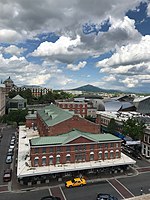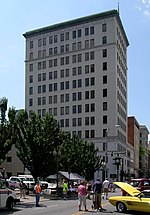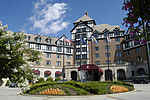Mill Mountain Theatre
1964 establishments in VirginiaRoanoke, VirginiaTheatres in VirginiaTourist attractions in Roanoke, VirginiaVirginia culture

Mill Mountain Theatre (MMT) is a professional equity theatre located in Roanoke, Virginia. Originally opening as Mill Mountain Playhouse as a “not-for-profit, non-Equity resident stock theatre”, the location burned down in 1976, leading to a re-opening and renaming at the Center in the Square in 1983. The theater is named after the nearby Mill Mountain, which is a popular theme for the naming of Roanoke landmarks and organizations, including the Mill Mountain Star, Mill Mountain Zoo, and Mill Mountain Coffee and Tea.Mill Mountain Theatre also has a longstanding relationship with Hollins University and the Hollins Theatre Institute.
Excerpt from the Wikipedia article Mill Mountain Theatre (License: CC BY-SA 3.0, Authors, Images).Mill Mountain Theatre
Market Square Southeast, Roanoke
Geographical coordinates (GPS) Address Nearby Places Show on map
Geographical coordinates (GPS)
| Latitude | Longitude |
|---|---|
| N 37.271477 ° | E -79.939451 ° |
Address
Center in the Square
Market Square Southeast 1
24011 Roanoke
Virginia, United States
Open on Google Maps











